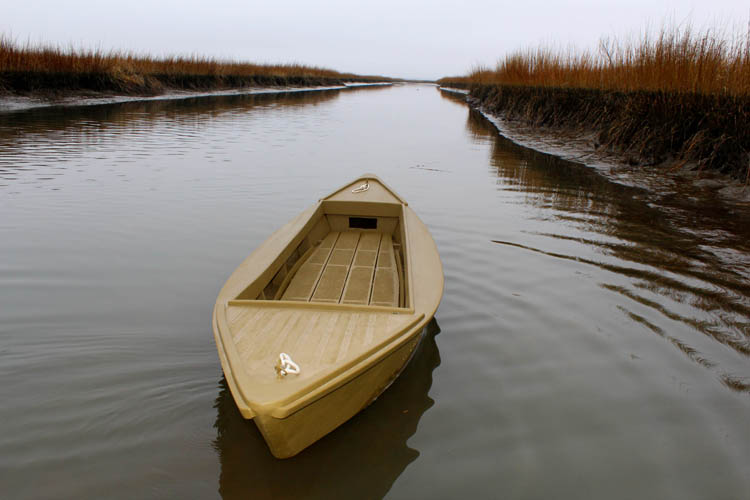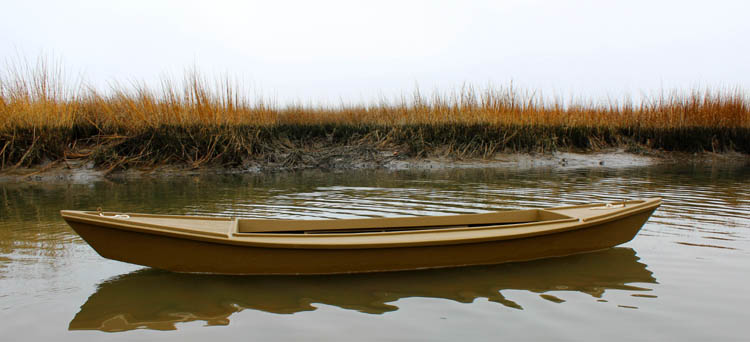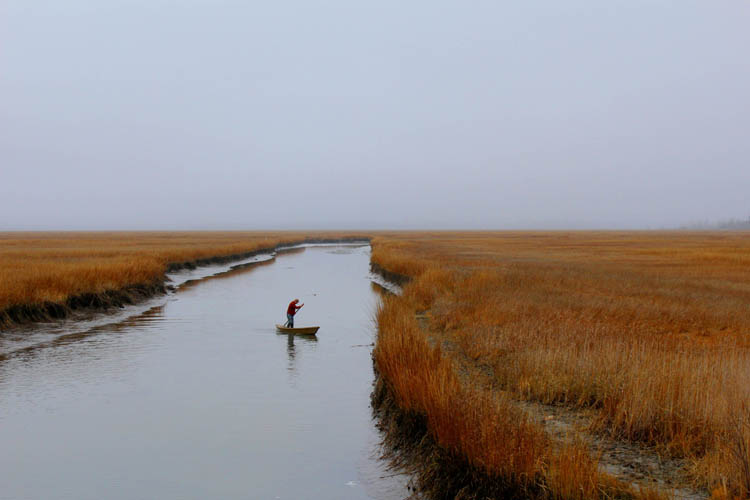jode hillman
Well-known member
Shortly after my Rail hunting excursion I decided that I wanted my own rail skiff. Their elegant lines, grace in shallow water and sheer “Cool” factor had made up my mind. Rail hunting however was at its zenith 100 years ago and while still actively undertaken, the traditional craft that are central to its practice are far from common. I scoured for sale ads and local boatyards without much luck. Those Skiffs I did find where museum pieces and priced accordingly. After several months I shelved my idea, resigned to the fact I would have to build one myself, someday.
Fast forward a few months. I was at local trappers rendezvous, where many woodsman’s, hunters, trappers and waterman congregate. During the show a multitude of topics come up in discussions and one such conversation turned to railbirds. A local bayman had heard I enjoyed rail hunting and I lamented to him about my lack of ability to find a skiff. He enlightened me he knew where one was, locally. I took note of exact directions and was flabbergasted to find it was at a farm just a few miles from my home.
Setting off post haste, I drove to the farm. Upon my arrival I was greeted by a farmer who wondered out loud “What are ya here for?” I inquired about the rail skiff and saw a light of recognition in his eyes. He led me out back behind the barn, where a forlorn, but beautiful skiff sat upside down on a trailer. When we flipped it over the skeletal remains of a possum along with its nest, fell out of the forward compartment. It was a wonderful boat, but surely had seen better days. The old fiberglass, set in polyester resin, was loose to the touch. The fore and aft White oak stems had significant rot. However the 11” steam bent cedar side planks were in good shape. As was the plywood bottom.
The farmer gave me a rundown to its history. The skiff was built for his father (an avid rail hunter) by Alvin Beal from Alloways Creek NJ in the early 1950’s. The farmer’s father used the boat extensively in the Rice meadows of the Cohansey River and other areas of southern NJ that held good numbers of Sora’s. After the boat was passed down to the farmer, he used it mainly to transport 110 conibear traps and the Muskrats they caught. It served him well for many years until he got an outboard powered skiff.
After the history lesson I inquired if he might sell the boat. Not surprisingly he was hesitant at first. This was part of his life and held many good memories. After some more conversation he asked” Will you fix her up and get her back on the meadows again?” After assuring him I would, I became the new owner for less than the cost of fueling up a tractor.
I transported the skiff to my workshop and began a thorough assessment. Its date of construction yielded a combination of old and new techniques and materials. While having Mahogany framing and cedar sides, the bottom and decks were plywood. The boat was a ‘tweener. Not old enough to warrant a restoration to original specifications, I decided I would take its classic shape and add proper decks, flooring and accoutrements to make it a rail Bird skiff that would serve for many more years of gunning. I hope you enjoy the photos of my rebuild, as I breathe new life into a south Jersey Classic.
------------------------------------------------------------------
The entire project, once underway took about 3 weeks to complete. This is a brief summation for sharing, I have dozens more pics and lots more information to share. More than I could remember for a single posting. Feel free to shoot questions my way. Jode
1: The rail skiff freshly arrived to my shop. Note the plywood decks which sit inboard of the sides.

2: The plywood decks and broken deck beams were removed to access and assess the for and aft compartments.

3: Both for and after outer stems had signifigant rot. They were removed and replaced with locally sawn white oak.

4: The new oak stems were fitted and fastened in place.

5: New deck beams were sawn out of Sassafras, the traditional wood for rail skiff framing. Sassafras is strong, light and rot resistant.

6: A Reinforcing piece of Sassafras was added where the tow rings will eventually be located.

Fast forward a few months. I was at local trappers rendezvous, where many woodsman’s, hunters, trappers and waterman congregate. During the show a multitude of topics come up in discussions and one such conversation turned to railbirds. A local bayman had heard I enjoyed rail hunting and I lamented to him about my lack of ability to find a skiff. He enlightened me he knew where one was, locally. I took note of exact directions and was flabbergasted to find it was at a farm just a few miles from my home.
Setting off post haste, I drove to the farm. Upon my arrival I was greeted by a farmer who wondered out loud “What are ya here for?” I inquired about the rail skiff and saw a light of recognition in his eyes. He led me out back behind the barn, where a forlorn, but beautiful skiff sat upside down on a trailer. When we flipped it over the skeletal remains of a possum along with its nest, fell out of the forward compartment. It was a wonderful boat, but surely had seen better days. The old fiberglass, set in polyester resin, was loose to the touch. The fore and aft White oak stems had significant rot. However the 11” steam bent cedar side planks were in good shape. As was the plywood bottom.
The farmer gave me a rundown to its history. The skiff was built for his father (an avid rail hunter) by Alvin Beal from Alloways Creek NJ in the early 1950’s. The farmer’s father used the boat extensively in the Rice meadows of the Cohansey River and other areas of southern NJ that held good numbers of Sora’s. After the boat was passed down to the farmer, he used it mainly to transport 110 conibear traps and the Muskrats they caught. It served him well for many years until he got an outboard powered skiff.
After the history lesson I inquired if he might sell the boat. Not surprisingly he was hesitant at first. This was part of his life and held many good memories. After some more conversation he asked” Will you fix her up and get her back on the meadows again?” After assuring him I would, I became the new owner for less than the cost of fueling up a tractor.
I transported the skiff to my workshop and began a thorough assessment. Its date of construction yielded a combination of old and new techniques and materials. While having Mahogany framing and cedar sides, the bottom and decks were plywood. The boat was a ‘tweener. Not old enough to warrant a restoration to original specifications, I decided I would take its classic shape and add proper decks, flooring and accoutrements to make it a rail Bird skiff that would serve for many more years of gunning. I hope you enjoy the photos of my rebuild, as I breathe new life into a south Jersey Classic.
------------------------------------------------------------------
The entire project, once underway took about 3 weeks to complete. This is a brief summation for sharing, I have dozens more pics and lots more information to share. More than I could remember for a single posting. Feel free to shoot questions my way. Jode
1: The rail skiff freshly arrived to my shop. Note the plywood decks which sit inboard of the sides.

2: The plywood decks and broken deck beams were removed to access and assess the for and aft compartments.

3: Both for and after outer stems had signifigant rot. They were removed and replaced with locally sawn white oak.

4: The new oak stems were fitted and fastened in place.

5: New deck beams were sawn out of Sassafras, the traditional wood for rail skiff framing. Sassafras is strong, light and rot resistant.

6: A Reinforcing piece of Sassafras was added where the tow rings will eventually be located.

Last edited:
















